What does blue chamomile look like and how to grow it?

Blue chamomile is a flower that attracts attention with its unusual appearance and pleasant aroma. Many gardeners grow a plant on their plots, successfully fitting it into the general concept of landscape design, but at the same time they do not even guess about the correct name.
Description
Blue chamomile is the name of the felicia plant, which is part of the Aster family. The flower is also called blue daisy or blue daisy. There are other varieties of names, but the main one.
Felicia has over 85 species, and most of it is found in southern Africa. Also, blue chamomile is found in Ethiopia and its surroundings. For the first time in Europe, the plant appeared in the 18th century.
Today the flower can be seen almost everywhere, including in Russia. Main characteristics:
- species - small baskets with flowers of the language type of blue;
- bud diameter - 3 cm;
- shoot length - 15 cm;
- the stem is powerful, practically without leaves.
There is one flower per stem. Interestingly, blue daisy is the only African flower that does not close its petals at night or in bad weather. The flowers only drop slightly due to lack of water or unfavorable conditions.



Felicia is considered one of the main elements of landscape design, with the help of which it is possible to collect original compositions and make the garden more attractive.
A characteristic feature of the flower is bushiness. Chamomile takes root pretty quickly and begins to grow in breadth, taking up all the free space. As soon as the plant gains strength, it immediately begins to bloom, releasing buds until the first frost. Mostly chamomile is planted next to yellow flowers, as it is the perfect combination of shades. Apart from its decorative properties, chamomile also acts as a healing flower.
It is used to make:
- natural cosmetics;
- essential oils;
- gels for washing.
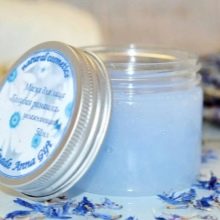


Chamomile inflorescences contain a large amount of nutrients, and natural remedies have a positive effect on the skin of the face. Finally, one of the main properties of blue chamomile is resistance to external influences. Felicia is not at all afraid of drought and sudden changes in temperature.
The disadvantage of chamomile is that it is too sensitive to humidity conditions indoors or in the area where the flower is grown. Excessive moisture leads to rot of the roots and stems of the plant, which is why it quickly dies.
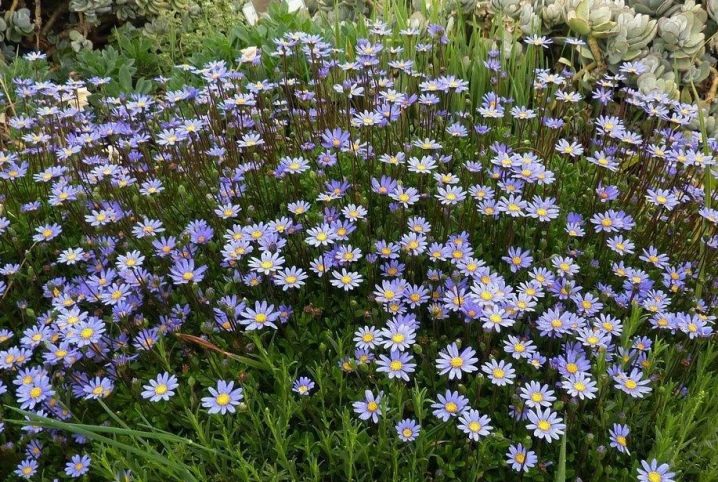
Types and varieties
Felicia was originally grown as a perennial houseplant. Therefore, taking care at home was different from taking care of the plantings on the street, which they came up with over time. Today, blue chamomile is used mainly in the garden for the purpose of decorating it.
In Russia, only 2 varieties of blue chamomile are distinguished, suitable for growing in harsh climates:
- amellic chamomile;
- berger.
It is worth taking a closer look at each option.

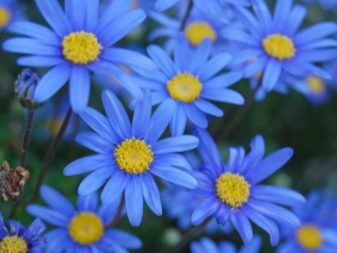
Berger
The second name of the popular variety is tender chamomile. Main characteristics:
- stem height - up to 20 cm;
- leaf color - light green;
- flowers are small in size, blue in color with a yellow core.
Despite its rapid growth, the bush is considered to be quite compact. Chamomile grows mainly in width, eventually acquiring the shape of a ball. The first flowers appear closer to the last days of July, the formation of buds occurs until frost appears.
At the end of this period, seed heads appear on the plant, from where the seed can be taken.
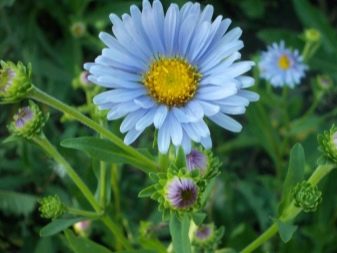
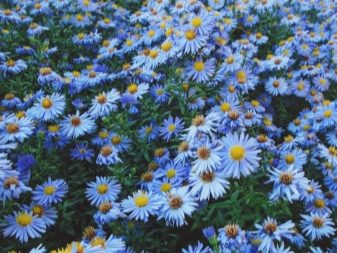
Amelloid
Amelloid chamomile is a felicia variety that first came to Europe towards the end of the 18th century. Among the features of the plant:
- external resemblance to aster camomile;
- type - perennial plant;
- stem height - 50 cm;
- flowers - dark turquoise;
- leaves are rich green, oblong in shape.
It should be noted right away that amelloid chamomile in indoor conditions is a perennial flower, but when planted in open ground, the culture may go into the category of annual plants.
Another feature of the variety is long and abundant flowering. The variety forms buds of turquoise and blue shades.
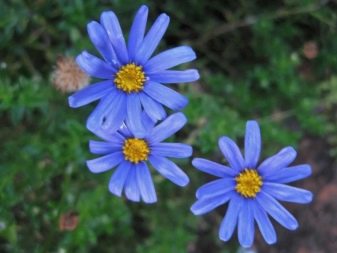
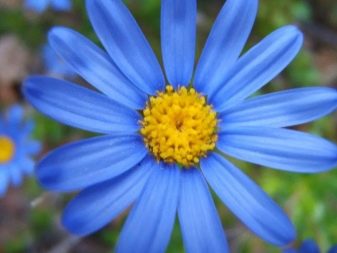
Landing
Before you start planting blue chamomile, you need to choose a suitable site and take into account the basic recommendations.
- The soil should be fertile, with a low acidity index. If desired, it can be increased with the help of special fertilizers.
- Preference should be given to sunny and slightly ventilated areas where there are no drafts.
- The water table should be low enough to avoid damaging the roots.
Seedlings of blue chamomile are already planted in open ground. To get it, the seeds are pre-prepared and then germinated. The main steps are presented below.
- Seed selection. At this stage, only intact and undeformed specimens are left.
- Aged at cold temperatures. Seeds placed in a cloth are refrigerated for 3 weeks.
- Disembarkation in a container. The procedure is carried out in early March. Usually the seeds are planted in small pots containing a fertile soil mixture. After planting, the soil is watered with warm, settled water, and after that the pot is covered with a transparent material.
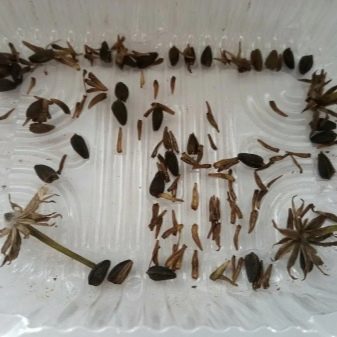
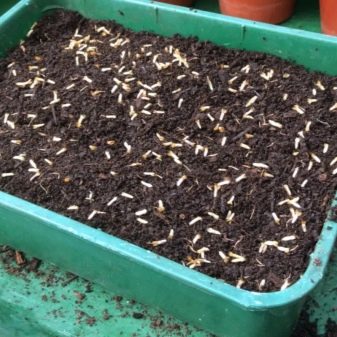
Planting seedlings in open ground is usually carried out in mid-May, following a certain pattern.
- The soil in the selected area is preliminarily loosened in order to saturate the earth with oxygen and microelements.
- Further, holes are made in the soil up to 5-7 cm deep.
- Saplings are carefully covered, leaving stems and leaves on the surface.
- Water the chamomile abundantly.
The distance between the seedlings should be 30 cm. The culture begins to bloom within 6 weeks from the moment of planting. Gardeners recommend covering young felicia from bright sunlight to prevent premature burning of leaves, stems and flowers.
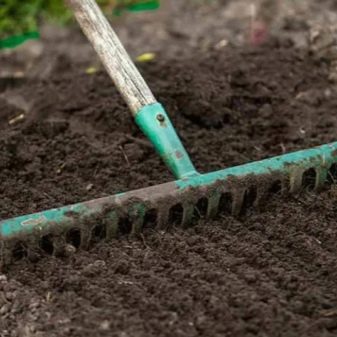
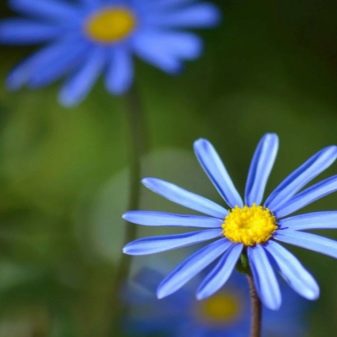
Care
In order for the chamomile to bloom constantly, it is worth taking care of the plant, performing all the necessary manipulations.
- Watering. It should be regular. You can determine the need for watering by the condition of the soil. If the soil is dry, an urgent need to water the felicia. In drought, gardeners recommend increasing the volume of water.
- Pruning. This involves removing dry or damaged stems and flowers. If this is not taken care of, the plant's immunity will weaken, and it will begin to be exposed to various diseases and pests. In addition, timely pruning of shoots will stimulate the growth of new flowers and the growth of chamomile.
- Top dressing. Fertilizers are recommended to be applied on average once every 2-3 weeks. As a top dressing, it is better to use complex compositions for ornamental crops. You can buy these fertilizers at gardening stores. Regular feeding increases the immunity of the plant, making it more resistant to frost.
Additionally, it is worth carrying out preventive treatment of chamomile from diseases and insects. Often the plant is attacked by powdery mildew, aphids or spider mites. It is recommended to process the plant before the formation of inflorescences.
Felicia is a cute and unusual plant that even an inexperienced gardener can grow. It is only necessary to take into account a number of recommendations and rules for planting and care.
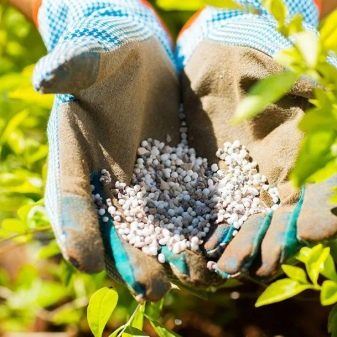








































































































The comment was sent successfully.